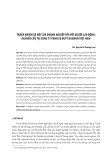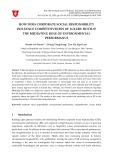
VNU Journal of Economics and Business, Vol. 4, No. 2 (2024) 46-57
46
Original Article
Sustainable corporate performance through corporate social
responsibility in the printing sector: The mediating role of
green product innovation and green supply chain
Le Thanh Tiep*
Postgraduate Education Institute, Ho Chi Minh City University of Economics and Finance
141 Dien Bien Phu Street, Binh Thanh District, Ho Chi Minh City, Vietnam
Received: November 8, 2023
Revised: January 10, 2024; Accepted: April 25, 2024
Abstract: The study investigates the impact of corporate social responsibility (CSR) on sustainable
corporate performance (SCP). Specifically, the study examines the mediating role of green product
innovation (GPI) and green supply chain (GSC) in this relationship. A quantitative method was
employed and used Smart PLS SEM to analyze the data collected from 418 respondents from
managers and senior managers in small and medium sized enterprises (SMEs) from the printing
industry in Vietnam. This study shows that there is positive impact from CSR to SCP. More
importantly, the study has investigated the existence of the mediating role of GPI and GSC in the
mechanism of these relationships. Through the analysis, the study brings about valued implications
to managers and senior managers in printing companies so as to achieve sustainable performance.
This study has highlighted the contributions of CSR, GPI and GSC in sustainability in Vietnamese
SMEs. The research will also help SMEs conduct their operational and strategic plans with a positive
influence on the environment, society, and the economy.
Keywords: Corporate social responsibility, green product innovation, green supply chain,
sustainable corporate performance.
1. Introduction*
Continuous performance stands as the
ultimate goal for every organization, for it is
through consistent performance that
organizations can expand and advance (Gavrea,
Ilies & Stegerean, 2011). With the dawn of
globalization, the demand for corporate
________
* Corresponding author
E-mail address: tieplt@uef.edu.vn
https://doi.org/10.57110/vnujeb.v2i6.137
Copyright © 2024 The author(s)
Licensing: This article is published under a CC BY-NC
4.0 license.
sustainability has surged significantly (Hansen
& Schaltegger, 2016). Companies are now
focusing not only on economic benefits but also
on environmental concerns (Svensson et al.,
2010). However, maintaining a competitive edge
in this context has become an increasingly
daunting challenge (Cancino et al., 2018). This
approach emphasizes the equal importance of
VNU Journal of Economics and Business
Journal homepage: https://jeb.ueb.edu.vn

L. T. Tiep / VNU Journal of Economics and Business, Vol. 4, No. 2 (2024) 46-57
47
each pillar – environmental, economic, and
social – in sustainability, leading to the
emergence of an integrative sustainability theory
(Tseng et al., 2015). Sustainable development, as
defined by the World Commission on
Environment and Development on 1987,
signifies meeting the present generation's needs
without compromising the ability of future
generations to meet their own. Sustainable
development encompasses economic,
environmental, and social (EES) performance.
The achievement of corporate sustainability lies
in the harmonious integration of these three
components, fostering efficiency, sustainable
growth, and shareholder value.
CSR stands as a strategic instrument,
enabling businesses to forge a competitive edge
geared towards sustainable development
(Abdelhalim & Amani, 2019), setting them apart
from competitors (EI-Garaihy et al., 2014). Over
recent decades, CSR has become integral to
managerial and administrative sciences (Pino et
al., 2016), emerging as a focal point in both
academic research and managerial practices
(Youn et al., 2018). Stakeholders' interest in
CSR has risen substantially, drawing attention
from researchers and practitioners alike, as noted
by Ghaderi et al., (2019) and Maqbool and
Zameer (2018). CSR significantly influences a
firm's success (Maqbool & Zameer, 2018) by
enhancing consumer perceptions, establishing
brand recognition, augmenting brand value,
reducing advertising and operational costs, and
attracting talent and investors (Li et al., 2015).
Consequently, CSR offers a multitude of benefits
to companies, fostering increased loyalty, trust,
positive brand sentiment, and the ability to counter
adverse publicity (Sen et al., 2006).
Seuring (2004) characterizes “environmental
supply chain management” as the strategic
coordination of material and information flows
across the supply chain. This integration aims to
meet customer demand for eco-friendly products
and services manufactured through
environmentally responsible processes. Key
business functions, such as purchasing,
manufacturing, marketing, logistics, and
information systems, need to be harmonized.
Strategic alignment is crucial, encompassing
customer focus, efficiency, quality,
responsiveness (Zelbst et al., 2010), and, more
recently, environmental sustainability. In the
face of supply chain competition and evolving
customer needs, practices that confer
competitive advantages must be identified and
embraced at the supply chain level. These
practices, as highlighted by Green et al. (2008),
necessitate collaboration between
manufacturers, suppliers, and customers to
enhance environmental sustainability. The
implementation of these green supply chain
management (GSCM) practices is anticipated to
lead to enhanced environmental performance,
indicated by reduced air emissions, effluent
waste, solid waste, and the use of toxic materials.
CSR has been viewed as a driver for GSC,
which in turn affects SCP and can be a mediator
for the relationship between CSR and SCP.
According to Quarshie et al. (2016), companies
that commit to social responsibility tend to
include managing their supply chain partners.
Further, GSC management and business
performance are significantly and favorably
correlated (Wang et al., 2020). Also, by
triggering space for innovation, CSR can be an
influence for GPI (McWilliams & Siegel, 2000).
The pursuit of GPI can bring a company
competitive advantages (Al-Abdallah & Al-
Salim, 2021), thus suggesting that GPI could
mediate the influence of CSR on SCP.
Even though SCP is gaining significant
attention alongside its response to CSR
initiatives and other factors of adding “greeness”
within a firm’s operation, literature on the
relationship between GPI and GSC on SCP
remains scarce. Also, the roles of GPI and GSC
as mediators in the relationship between CSR
and SCP are still vague. Thus, this lack in the
literature raises the following research questions:
RQ1: How do CSR, GPI, and GSC engage in
boosting SCP?
RQ2: Does GPI and GSC contribute as
mediating roles in the relationship between CSR
and SCP?
This study investigates the impact of CSR,
GSM, and GPI on SCP in Vietnam and
hence adds to the scholarly conversation.
Additionally, the study intends to demonstrate
the major contribution of CSR to improving SCP
by revealing an indirect association between
CSR and SCP that is mediated through GPI and
GSM. This academic project complements
Stakeholder Theory, supports the Resource-
Based View theory, and supports the

L. T. Tiep / VNU Journal of Economics and Business, Vol. 4, No. 2 (2024) 46-57
48
Knowledge-Based View, adding to the field's
academic framework. This study also provides
corporate leaders with insights into a
comprehensive strategy that integrates CSR,
GSM, GPI, and SCP for long-term success. The
report emphasizes the significance for company
executives and managers to integrate sustainable
practices into every aspect of their businesses,
underlining that achieving SCP is an extended
effort that calls for an all-encompassing strategy.
2. Literature review and hypothesis development
2.1. Theoretical underpinnings
According to Freeman’s (1984) stakeholder
theory, an organization consists of different
stakeholders, meaning people who draw impacts
and who can be impacted by the operation of the
firm. These stakeholders have different interests;
thus, it is necessary that the organization
understands its stakeholders thoroughly in order
to achieve superior performance. The
stakeholder-based approach is critical for firms
that aim to achieve sustainable performance for
many reasons, one of which is that the more a
firm promotes a positive relationship with its
stakeholders, the higher the level of synergy it
will establish. The stakeholder-based approach
also pushes managers towards striving for not
only financial values but also social
responsibility (Fauzi et al., 2010).
The Resource-Based View (RBV) theory has
emerged as a cornerstone in strategic
management literature, offering valuable
insights into how organizations can attain and
sustain competitive advantages through their
unique resource endowments. Barney (1991)
stated that any assets, skills, organizational
procedures, information, expertise, etc. that
firms control are referred to as resources and
emphasized the importance of four critical
attributes of resources – value, rarity,
inimitability, and non-substitutability (VRIN) –
in determining their potential to create
sustainable competitive advantages.
Additionaly, Barney (1991) formulated the
notion of combining RBV and stakeholder
theory, citing the possibility for an effective
approach to assist with managerial problems.
Grant’s (1996) Knowledge-Based View
(KBV) argues that in addition to traditional
tangible resources, knowledge is a distinct and
critical strategic resource for firms. He posits
that firms gain and sustain competitive
advantages by effectively managing and
leveraging their knowledge assets. According to
Grant (1996), there are two kinds of knowledge:
tacit and explicit knowledge, in which, tacit
knowledge is personal and context-specific,
residing in the minds of individuals, while
explicit knowledge is codified and can be
documented. Firms need to manage both forms
of knowledge effectively. The knowledge-based
view (KBV) posits that the core competence of a
corporation comes from its tacit knowledge.
Companies integrate and innovate internal
personal knowledge to create new valuable
expertise while also effectively obtaining
external knowledge to enhance their competitive
advantage.
2.2. The nexus between CSR and GPI
Numerous studies have demonstrated how
CSR may open the door to innovation by
utilizing social, environmental, or sustainability
factors to develop innovative business
frameworks, potential markets, and novel
products, services, and processes (Wagner,
2010; Guoyou et al., 2013). Businesses with a
particular CSR focus can improve their capacity
for innovation (Bocquet et al., 2013; Marin et al.,
2017). The possibility to improve sustainability
management performance while fulfilling
natural preservation regulations is perhaps where
the value of green innovation lies. According to
many researches, there is a link connecting CSR
and innovation (McWilliams & Siegel, 2000).
As businesses realize that green innovation
greatly enhances the preservation of the
environment and sustainable commercial
development, green innovation has grown into
an important component of CSR strategy. Thus,
based on the above discussion, the hypothesis is
suggested as below:
H1: CSR has a significant impact on GPI.
2.3. The nexus between CSR and GSC
By engaging in and expanding
environmentally friendly technologies to

L. T. Tiep / VNU Journal of Economics and Business, Vol. 4, No. 2 (2024) 46-57
49
generate and convey ecological products, assess
the sustainability of the products, and complete
their CSR with regard to environmental
responsibility, manufacturers make significant
endeavors to supply green products (Hong &
Guo, 2018). In improving the "greenness" the
supply chain would entail a set of principles and
practices that take into account both internal and
external stakeholders throughout the entire
manufacturing flow. CSR is viewed as the
internal effects that are connected to the
unforced active techniques that achieve an edge
over competitors and greater purchasing power,
optimize corporate image and brand, fulfil the
anticipated social responsibility, and attract
consideration from environmentally conscious
customers. Organizations embracing social
responsibility are now expanding their CSR
operations to encompass controlling of their
supply chain partners with the goal to achieve
harmonization (Quarshie et al., 2016). Thus,
based on the above discussion, the hypothesis is
suggested as below:
H2: CSR has a significant impact on GSC.
2.4. The nexus between GPI and SCP
By possibly mitigating the adverse impacts
of environmental weaknesses with a positive
influence on the world as a whole, eco-
innovation boosts the competitive edge of SMEs
(Ifrim et al., 2018). As a result, the research
suggests that developing green products can give
an organization a competitive edge (Al-Abdallah
& Al-Salim, 2021). GPI has gained prominence
in recent years as one of the most important
elements in achieving economic expansion and
preservation of the environment (Dangelico &
Pujari, 2010). According to research by Carrillo-
Hermosilla et al. (2010), eco-innovations have
the potential to open up new commercial
prospects. In order to investigate the impact of
competitive pressure on business investments in
environmentally friendly production, Yalabik
and Fairchild (2011) created an economic
analysis. Their findings demonstrated that
competition for customers who care about the
environment can increase the efficacy of
environmental advances. According to the
findings of Pujari's (2006) assessment on
environmental new product development
initiatives in North America, eco-innovation
activities have a favorable effect on market
outcomes. Thus, based on the above discussion,
the hypothesis is proposed as below:
H3: GPI has a significant impact on SCP.
2.5. The nexus between GSC and SCP
Large organizations can afford to purchase
and carry out environmental systems like
contamination preventive measures and reverse
logistics programs because they have the
financial and human resources to do so. This
positively affects their corporate performance
outcomes. (Younis & Sundarakani, 2019) GSC
management adoption enhances operational
efficiency for big and medium-sized
organizations, according to research by
Vijayvargy et al. (2017). According to Wang et
al. (2020), there is a positive and substantial
correlation between GSC management and
company performance. According to Luthra et
al. (2016), increasing market share and
profitability for businesses is seen as a key
approach for boosting their overall success.
Nejati et al. (2017) and Zaid et al. (2018) have
also demonstrated that GSC management
increases operational effectiveness with a cost-
cutting focus. By incorporating green initiatives
and green practices into SCP, businesses
throughout the whole supply chain increase
corporate performance for sustainability and boost
environmental performance (Zaid et al., 2018).
H4: GSC has a significant impact on SCP.
2.6. The nexus between CSR and SCP
Corporate Social Responsibility (CSR)
wields an impact on both financial and non-
financial performance indicators, while some
research indicates that CSR initiatives can
enhance economic outcomes and performance
(Javed & Husain, 2021; Malesios et al., 2021).
Depending on the context, CSR can influence
social welfare and emissions (Fukuda &
Ouchida, 2020). Furthermore, CSR efforts can
bolster consumer perceptions and enhance
employee satisfaction (Brunton et al., 2017;
Fatima & Elbanna, 2020), both of which are non-
financial facets of performance. Considering that
CSR can also foster improved relationships with
stakeholders, employee motivation,
productivity, and corporate reputation, the
following hypothesis is posited:

L. T. Tiep / VNU Journal of Economics and Business, Vol. 4, No. 2 (2024) 46-57
50
H5: CSR has a significant impact on SCP.
2.7. The mediating role of GPI and GSC in the
relationship between CSR and SCP
Empirical studies have shown that CSR practices
can influence a firm’s GPI and GSC as a firm’s
increased level of CSR can enhance its
innovation capability and also its proactivity in
managing its environmental impacts (Bocquet et
al., 2013; Marin et al., 2017; Huang et al. 2021).
Moreover, studies have also suggested that GPI
has a significant relationship with SCP (Al-
Abdallah & Al-Salim, 2021) and GSC
management has a positive and significant
relationship with SCP. Thus, based on the above
discussion, the hypotheses are proposed
as below:
H6: GPI mediates the relationship between
CSR and SCP.
H7: GSC mediates the relationship between
CSR and SCP.
2.8. Proposed research model
Considering the presented empirical data and
the hypothesis put forward, the research model
shall be structured with 4 variables: 1
independent variable (CSR), 2 mediating
variables (GPI and GSC) and 1 dependent
variable (SCP).
----------- mediating relationship (H6, H7)
Figure 1: Proposed research model
Source: Author.
3. Research methodology
3.1. Target population, sample procedure
The target population of this research
includes printing companies in the South East of
Vietnam. The targeted respondents will be
middle to senior-level managers. The key criteria
applied to identify the size of business is the total
number of employees, according to OECD
(2021). Following this standard, enterprises with
10 to 49 employees are defined as small
businesses, and with 50 to 249 employees are
medium-sized enterprises.
3.2. Survey instrument and measures
Data collection primarily relies on a
meticulously designed questionnaire, structured
around the variables outlined in Table 1. The
questionnaire underwent a rigorous validation
process, including expert review and pilot
testing. It is divided into two sections: Section 1
captures demographic information, while
Section 2 comprises open-ended questions
related to CSR, GPI, GSC, and SCP within the
context of SMEs in Vietnamese printing
companies. Participants provide their responses
on a 5-point Likert scale, ranging from 1
(strongly disagree) to 5 (strongly agree).
Detailed descriptions for each variable can be
found in Table 1.
4. Results
4.1. Sample characteristics
There were 575 questionnaires with an open
letter to emphasise the seriousness and practical
orientation of this study. At the end of the
survey, 426 responses were collected, which
accounted for a 74% response rate. After
filtering out invalid response sheets (incomplete
H6
H2
H4
H7
H5
H1
Corporate social
responsibility (CSR)
Green product
innovation (GPI)
Green supply chain
(GSC)
Sustainable corporate
performance (SCP)
H3


























